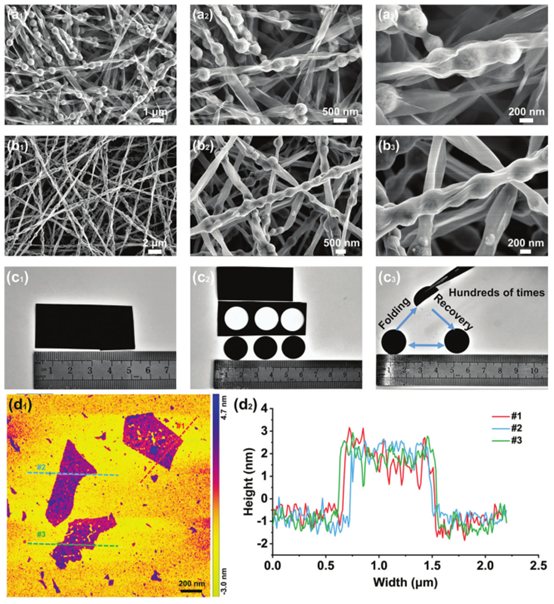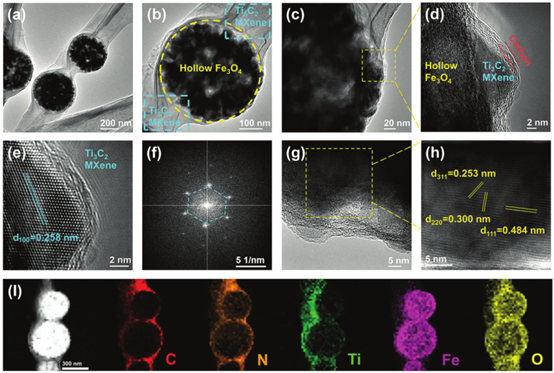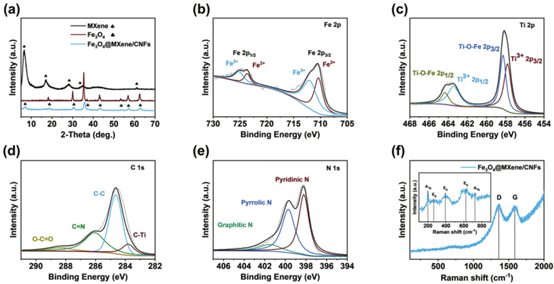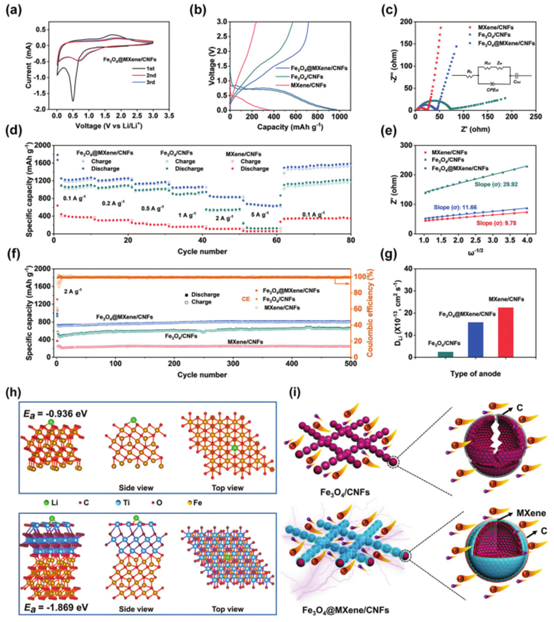
hotline:
17715390137
Tel/Wechat:
18101240246 (Technology)
0512-68565571
Email:mxenes@163.com (Sales Engineer)bkxc.bonnie@gmail.com
Scan the code to follow or search the official account on WeChat:
2D Materials Fronrier After paying attention,
click on the lower right corner to contact us,
Enter enterprise WeChat.
Professional Services Online




With the increasing demand for high-energy and high-power energy storage devices, lithium-ion batteries (LIBs) are facing both challenges and opportunities. Fe3O4 has the advantages of high specific capacity, abundant natural reserves, environmentally friendly, non-flammable, and good safety. It is one of the promising anode materials in lithium-ion batteries and a potential substitute for commercial graphite anodes. However, its slow intrinsic reaction kinetics and huge volume changes severely limit the reversible capacity and cycle life of the battery.
In order to overcome these obstacles and improve the cycle life of Fe3O4, we designed a one-dimensional (1D) nanochain structure, which consists of 2D Ti3C2 encapsulated Fe3O4 hollow nanospheres uniformly coated in nitrogen-doped carbon nanofibers ( Fe3O4@MXene/CNFs), and use it as a high-performance anode for lithium-ion batteries. The unique 1D nano chain structure not only inherits the high electrochemical activity of Fe3O4, but also exhibits excellent electronic and ionic conductivity. The Ti3C2 layer on the Fe3O4 hollow nanospheres provides the main electron transmission path, while the nitrogen-doped carbon nanofiber network provides the second electron transmission path. At the same time, Ti3C2 flakes partially alleviate the volume change of Fe3O4 caused by Li+ in the process of insertion and extraction. In addition, density functional theory calculations show that the Fe3O4@MXene/CNFs electrode can effectively enhance the adsorption of Li+, thereby improving the electrochemical reaction kinetics and promoting the storage of Li+. Due to the use of electrospinning technology, the confinement effect of nanofibers can prevent the self-stacking of Ti3C2 flakes and the aggregation of Fe3O4 nanospheres, resulting in a larger specific surface area and more accessible electrochemical reaction active sites on the flexible anode.

Recently, the team of Professor Yongsong Luo from Xinyang Normal University used electrostatic adsorption self-assembly and electrospinning to design a one-dimensional (1D) nanochain structure. The structure is composed of 2DTi3C2 encapsulated Fe3O4 hollow nanospheres uniformly coated in nitrogen doped Composed of carbon nanofibers. PDDA-modified hollow Fe3O4 nanospheres and ultra-thin MXene nanosheets are electrostatically self-assembled in DMF solution, and PAN is added to obtain a black spinning solution. Fe3O4/MXene/PAN nanofibers are prepared by high-voltage electrospinning and carbonized under protective gas to form Fe3O4@MXene/CNFs. In this structure, MXene and carbon nanofibers provide dual electron paths. The Ti3C2 layer on the surface of the hollow Fe3O4 nanospheres is the main electron transfer route, while the nitrogen-doped carbon nanofibers form the secondary electron transfer route. In addition, the nano-chain structure can buffer the volume expansion caused by Fe3O4 and help to form a more stable SEI film to improve cycle stability. At the same time, the Fe3O4@MXene/CNFs electrode can effectively enhance the adsorption of Li+, which has been confirmed by density functional theory calculations. Therefore, the Fe3O4@MXene/CNFs composite material shows a very high specific capacity (1786mAh g-1); excellent capacity retention (the reversible capacity after 500 cycles at a current density of 2A g-1 is 806mA h g-1) And excellent area specific capacity (when the current density is 4mA cm-2, the area specific capacity is 1.612mAhcm-2).
The results were published online in the internationally renowned journal Nanoscale (impact factor 6.895) with the title: MXene-encapsulated hollow Fe3O4 nanochains embeddedin N-doped carbon nanofibers with dual electronic pathways as flexible anodes for high-performance Li-ion batteries. Guo Ying is the first author of this article.


Figure 1. Schematic diagram of the preparation process of Fe3O4@MXene/CNFs nanocomposites.

Figure 2. Morphological characterization of the material. (a1-3) Fe3O4/MXene/PAN fiber, and (b1-3) SEM image of Fe3O4@MXene/CNFs; (c1-3) Digital photo of flexible Fe3O4@MXene/CNFs film and flexibility test; (d1-2 ) Atomic force microscope image and thickness distribution of Ti3C2 nanosheets.

Figure 3. TEM characterization of the material. (ac) TEM image of Fe3O4@MXene/CNFs; (d, e, g and h) HRTEM image of Fe3O4@MXene/CNFs; (f) Fast Fourier Transform (FFT) image of (e); (i) ) Fe3O4@MXene/CNFs element mapping image.

Figure 4. Structural characterization of the material. (a) XRD patterns of MXene flakes, Fe3O4 and Fe3O4@MXene/CNFs; (b) Fe 2p (c) Ti 2p (d) C 1s and (e) N 1s high-resolution XPS spectra of Fe3O4@MXene/CNFs; (f) Raman spectra of Fe3O4@MXene/CNFs.

Figure 5. Electrochemical performance. (a) CV diagram at 0.2 mV s-1; (b) First-lap constant current charge and discharge curves of different materials at 2A g-1; (c) Impedance diagram and (d) Different electrodes at 0.1, 0.2, 0.5, Rate performance under 1.0, 2.0, 5 A g-1; (e) Warburg coefficient of different electrodes. (f) Cyclic performance at a large current density of 2 A g-1; (g) Lithium ion transfer coefficient; (h) Density functional simulation of lithium adsorption configuration; (i) Schematic diagram of ion/electron transport.

In this paper, using the high theoretical capacity of Fe3O4 and the high electronic conductivity and flexibility of Ti3C2, one-dimensional (1D) nano-chain structures (Fe3O4@MXene/CNFs) are controllably prepared using electrostatic adsorption self-assembly and electrospinning methods. The design of a dual electron channel composed of Ti3C2MXene and N-doped carbon nanofibers not only greatly improves the electrical conductivity and ionic conductivity of the Fe3O4 nanospheres, but also keeps the structure of the Fe3O4 nanospheres stable during the cycle. In addition, the self-stacking of Ti3C2 and the aggregation of Fe3O4 are significantly reduced, allowing more accessible active sites on the flexible anode.
Literature link:
https://doi.org/10.1039/D0NR09228B

| Reminder: Beijing Beike New Material Technology Co., Ltd. supplies products only for scientific research, not for humans |
| All rights reserved © 2019 beijing beike new material Technology Co., Ltd 京ICP备16054715-2号 |